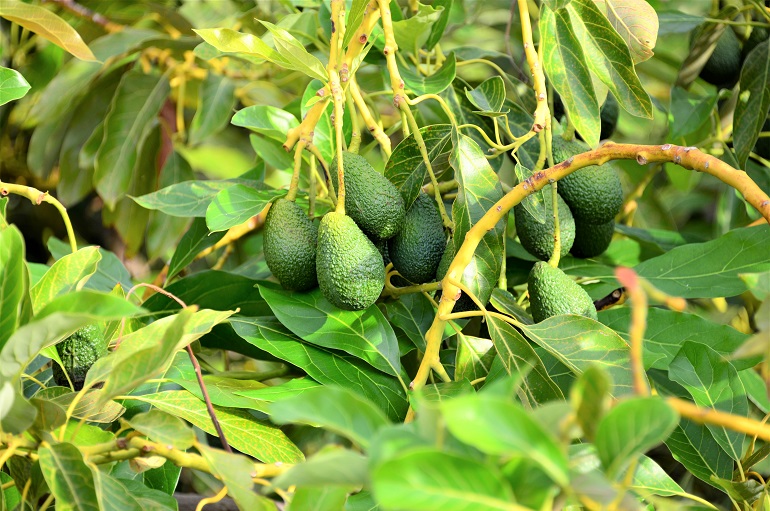Avocado Harvest, Yield per hectare and Storage

This post is also available in:
This post is also available in:
![]() Español (Spanish)
Español (Spanish) ![]() Français (French)
Français (French) ![]() Deutsch (German)
Deutsch (German) ![]() हिन्दी (Hindi)
हिन्दी (Hindi) ![]() Türkçe (Turkish)
Türkçe (Turkish) ![]() 简体中文 (Chinese (Simplified))
简体中文 (Chinese (Simplified)) ![]() Ελληνικά (Greek)
Ελληνικά (Greek) ![]() Português (Portuguese (Brazil))
Português (Portuguese (Brazil))
Yield, Harvest, and Post-Harvest handling of Avocado
The harvest, storage, packaging, and transportation of avocados are the most important processes of the food value chain and greatly affect the quality of the product.
Avocado yield per hectare and acre
The yield of an avocado tree depends on the following:
- Age of the tree
- Variety
- Environmental conditions
- Plant vigor and health (successful plant protection, fertilization, and irrigation)
An avocado tree starts producing fruits 3-4 years after planting, but the farmer will begin having economic gain after the 6th year. Depending on the year, my avocado trees (25 years old) produce an average of 70 to 80 kg (154 to 176 lbs.) of fruits per tree. However, based on international references, the yield of a mature tree per year may vary from 45 to 320 kg (100-700 lbs.) or 7-13 tonnes per hectare (6245 to 11598 lbs. per acre) (1, 2). The size of the fruit is an important quality characteristic. Avocadoes are commercially acceptable when they weigh between 150 and 500 grams (0.33-1.1 pounds), but 400 g (0.88 pounds) is ideal. To achieve this, farmers need to perform all agricultural practices necessary to balance the amount and the size of the fruits produced on a tree.
In my fields in Crete, Greece (Mediterranean climate), I grow Zutano, Fuerte, and Hass avocado trees, with Zutano being the most productive among the 3 of them, followed by Hass and Fuerte. However, Hass may exhibit alternate bearing (more production in one year and less during the next). The phenomenon is stronger in trees that do not get pruned. By checking testimonials from other avocado growing areas with similar climates, like California, we saw that our yield areas are similar, with experienced growers mentioning that Hass can yield 8-13 tonnes per hectare (t/ha) (7137 – 11598 lbs. per acre) and Fuerte 7-11 t/ha (6245 to 9813 lbs. per acre) (3). However, if all conditions are favorable and the growers use suitable rootstocks, successfully control root rot, and apply irrigation and fertilization, they can achieve yields of even 20-23 tons per hectare (17843 to 20520 lbs. per acre) (2, 4). Keep in mind that the yield per hectare or acre is affected not only by the production per tree but also by the plant density and the number of trees per hectare.
Harvesting time and method
Depending on the variety, the moment and duration of harvesting differ and are generally relatively fixed over the years. At the end of October (mid-autumn), we start picking the Zutano fruits. Due to their high sensitivity, harvesting needs to be completed very fast and carefully in order to maintain their good quality. The short period of time that the mature fruit remains attached to the tree and the early harvest seems to have a very positive impact on the amount of the yield. This way, the trees have a more extended period to “rest” and relocate all the nutrients and boost flower bud differentiation (next season’s production).
The situation is very different for Fuerte trees harvested right after the Zutano. In this case, harvesting can start from the beginning of November (start of winter) and lasts until May (end of spring). As you see, the “harvesting window” is very extended, allowing a steady supply to the market. However, at the same time, that means that we need to enter our field multiple times, something that many of my fellow avocado growers do not like because it costs a lot of money. Finally, we harvest the “summer avocado,” the Hass, during June and July.
While the harvesting moment has remained relatively stable over the years, a farmer needs to be able to detect the “right” moment to achieve the best quality and longer shelf-life. Avocado has a high rate of post-harvest respiration and is classified as climacteric fruit. This means that it has a relatively short shelf-life and continues to ripe even after harvest. However, if the fruit is harvested before it is mature, there is a high risk that it will shrink, have a bitter taste, and have a very firm-unpleasant texture.
Since Avocados do not soften on the trees, it is not easy to identify the right harvesting period. Some indicators and methods to determine avocado maturity include:
- Optical observations:The change of color of the pile:
- in dark varieties like Hass from green to black-purple
- in green varieties, the fruit stem turns yellow, and the skin may appear less shiny (powdery appearance) with rust-like spots
- By harvesting a few fruits and storing them at room temperature for 7-10 days. If they soften without shriveling and taste as expected, the fruit is ready for harvesting. We use this technique for Zutano and Fuerte that keep their green color even when they mature.
- Dry matter test
Fruit of all cultivars must reach a minimum of 21% dry matter (4). This number differs between varieties. For example, Hass should be harvested when the dry matter content of the fruit is at least 23%. The Australian Agriculture and Food department suggest the use of the following formula to calculate dry matter content (5):
weight of the dried avocado sample (less weight of the container), multiplied by 100, divided by the weight of the fresh avocado sample (less weight of the container).
Calculation example:
Weight of fresh avocado sample (less weight of the container) = 125g (0.27 pounds)
Weight of dried avocado sample (less weight of the container) = 30g (0.06 pounds)
30g multiplied by 100 divided by 125g
= 24% dry matter
It is highly advised to harvest the fruits as soon as they reach these minimum levels because there is also an upper level of dry matter (maturity), after which palatability drops significantly.
- Oil and fatty acid content measuring
The minimum oil content of 8% is necessary for marketing avocados (Ozdemir et al., 2004).
Finally, the farmer should follow the following principles:
- Harvest only during dry conditions.
- Pick the fruits from diseased trees last to minimize pathogen movement in the field and keep them separately from the healthy ones in storage.
- Harvest as soon as the fruit matures to reduce the damage caused by trips.
- Leave 0.5 cm of stem attached to the fruit.
- Take all prevention and control measures to decreaseanthracnose infection in the fruits.
- If there is a great fluctuation in the size and maturity level of the fruits in the tree or the orchard, start by picking the largest (more ripe) fruits first.
- Avoid picking the fruits from the ground or/and hit the trees with sticks to make the avocado drop.
- Use cotton gloves in order to protect the fruits.
On the larger orchards, trees are harvested with hydraulic ladders (cherry pickers), while on the smaller properties picking poles are used to reach the fruit from the ground. Fruit is picked into large bins, usually mounted on trailers. It is essential to keep the fruit out of direct sunlight after harvest to prevent it from heating (4).
Post-harvest handling
The maturity level at the moment of harvest and the environmental conditions affect the storage life of the avocado fruits. For example, the fruit can be consumed 20 days after picking from the tree in early harvesting during winter, while this period decreases to 7-8 days during summer. While I don’t do it myself, many farmers apply pre-cooling treatment to their fruits. This should happen within 5 hours from the harvest, followed by storing them at 5oC (41 oF). In other cases, a hot-water treatment can be applied to sanitize the fruits (immerse in 30oC (86 oF) water for 3-5 min) (1). This can help in the post-harvest control of anthracnose.
Soon after harvesting, we focus on cleaning, shorting, and grading the fruits based on their size and health-quality status. This procedure is very important since the avocado is marketed in 4 kilos boxes that can usually fit 12, 14, or 16 fruits, which will define the final price. Based on data from other countries, there are more size categories with the 4-kilo cartoons to fit from 4 (781-1,222 g or 1.7-2.7 pounds each) to 22 avocados (171-190 g or 0.37-0.4 pounds each). Avocados are exclusively packed in cartons made of solid or corrugated fibreboard. Plastic should be generally avoided.
The fruits can be stored for 3-5 weeks at a temperature of 4-5 oC (39-41 oF) and relative humidity of 85-95%. It is very important to avoid any temperature fluctuations within the storing area or/and during transportation because it can decrease the quality of the product. We see this problem, especially in avocados imported from abroad. Finally, the farmer can use insulated or refrigerated trucks (6) for transportation.
References
- https://www.kalro.org/sites/default/files/avocado–production–cultivation.pdf
- https://www.daf.qld.gov.au/business–priorities/agriculture/plants/fruit–vegetable/fruit–vegetable–crops/avocado/harvesting–avocados
- https://www.avocadosource.com/Journals/SAAGA/SAAGA_1991/SAAGA_1991_PG_15-18.pdf
- https://www.fao.org/3/x6902e/x6902e.pdf
- https://www.agric.wa.gov.au/avocados/avocado–maturity–testing–using–dry–matter
- https://www.jica.go.jp/project/english/kenya/015/materials/c8h0vm0000f7o8cj–att/materialspdf
Ozdemir, F., & Topuz, A. (2004). Changes in dry matter, oil content and fatty acids composition of avocado during harvesting time and post-harvesting ripening period. Food Chemistry, 86(1), 79-83.
History, Nutritional Value and Plant Information of Avocado
All Avocado Varieties Explained- Characteristics and Advantages
Avocado Tree Climate and Soil Requirements – Planting Avocado Trees
Avocado Tree Propagation and Pollination
Avocado Tree Water Requirements and Irrigation Systems
Avocado Fertilizer Requirements
Training and Pruning of Avocado Tree
Avocado Harvest, Yield per hectare and Storage








































































